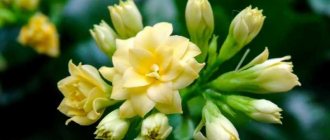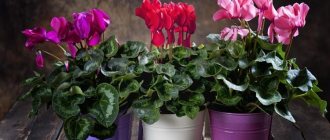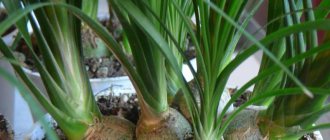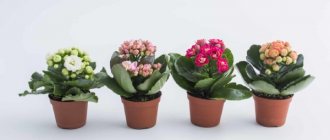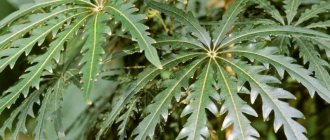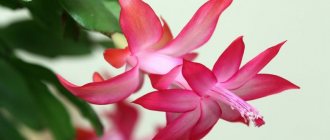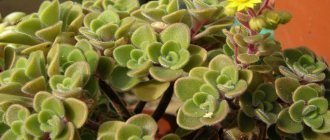An unusual and amazing plant is Kalanchoe, whose homeland and origin are hot African countries. In its natural habitat, the shrub can be found in Australia and America. The succulent is amazing not only for its beautiful flowering, but also for its beneficial properties. The flower is used in folk medicine because it has anti-inflammatory, disinfectant and analgesic properties.
The medicinal plant is distinguished by fleshy leaves that are smooth or rough to the touch, depending on the type. The color of the inflorescences also depends on the variety. The type of Kalanchoe root system is fibrous.
Interesting fact! There are about two hundred varieties of Kalanchoe. Some varieties were bred artificially and do not grow in nature.
What does Kalanchoe look like?
It is a genus of plants with enormous diversity. Kalanchoes differ greatly from each other in height, leaf size, stem shape and even color. It is best to study Kalanchoe in a photo. It is noticeable from them that the genus includes trees 4 meters tall and bushes 20 cm tall.
The plant is rich in shades. The leaves and stems range from bright green to blue-blue. There are both round and sharp leaf shapes.
Flowering and pruning
The succulent blooms can be observed in winter. It can last from several weeks to six months. The color of the inflorescences depends on the type of succulent. Kalanchoe with red flowers is amazingly beautiful; it is also called the Christmas flower. Crimson Kalanchoe is no less impressive, because its color will harmoniously fit into any apartment interior.
Attention! Pruning must be done in the spring season.
For lush flowering of the plant, you need to trim the old peduncles and also remove some of the branches. A trimmed succulent will look attractive and well-groomed.
Varieties
If you need Kalanchoe with medicinal properties, then there are only three varieties:
- Kalanchoe Degremona, it has elongated leaves with a sharp end and teeth along the edge. It does not bloom, but reproduces well, producing babies on its teeth.
- Kalanchoe pinnate is a flowering plant with small pink-yellowish flowers. This house doctor is grown to produce medicines for the treatment of surgical, gynecological and dental diseases.
- Kalanchoe Blossfeld - It blooms with small white, red or orange flowers. The flowering period occurs in winter and spring. It has very distinctive leaves, they are fleshy and shiny.
Other species are also popular for growing Kalanchoe at home, requiring a minimum of plant care skills. But these three varieties have medicinal properties.
Coloring of flowers of different varieties of Kalanchoe
This table will help with choosing a Kalanchoe variety depending on the preferred shade of flowers. All varieties look impressive in the interior of any apartment.
| Color shade | Kalanchoe variety |
| white-flowered | Mie; Elsa; Pluto; Cora White |
| Rosaceae | Delia; Dion; Cora; Katherina; Melanie; Gwenn |
| orange- and yellow-flowered | Karen; Fonda; Ingrid; Goldstrike; Naomi; Arina; Nadia-2000; Сarmen; Cardot |
| red-flowered | Cassandra; Fuego; Kawi; Mary; Kerr |
How to properly collect and store
The plant grows all year round. If you need a leaf, you can come up at any time and pick it. If Kalanchoe is being prepared for planned treatment, then the preparation is approached scientifically:
- stop watering, wait a week;
- cut off the lower leaves;
- wash the raw materials thoroughly in running water and wipe dry;
- keep in the refrigerator in the bottom fruit drawer for 5-7 days.
This step-by-step collection process allows the beneficial properties to develop and accumulate. Properly prepared leaves can be used to make infusions, ointments and other dosage forms.
Proper watering and fertilization
Overmoistening is dangerous for Kalanchoe. If there is too much moisture, the roots may rot and dangerous diseases will develop. Therefore, it is important to observe moderation and know the rules of watering.
In summer and spring it should be moderate. The soil should dry out between waterings. In autumn and spring you need to reduce the amount of water; one watering every 14 days will be enough. During the cold period, you need to make sure that the water does not stagnate in the pan, this can lead to hypothermia of the plant, and it does not tolerate this well.
At any time of the year, experts recommend using settled water at room temperature. Be sure to ensure that liquid does not get on the stem, otherwise it may rot.
Kalanchoe does not require frequent feeding. In winter there is no need to do this at all. If you purchase ready-made fertilizer for succulents, half the dose indicated on the package is enough. The drug is dissolved in warm water, then the solution is cooled to room temperature and the plants are watered with it.
Medicinal properties
Such a rich chemical set determines the long list of medicinal properties of Kalanchoe:
- Promotes rapid regeneration.
- Destroys pathogenic microorganisms and demonstrates good bactericidal and bacteriostatic properties.
- Inhibits the development of the inflammatory process.
- Stops minor bleeding, has a beneficial effect on blood flow, so it can help even with varicose veins.
- Solves problems of skin diseases.
The plant is used to treat female diseases; it promotes rapid healing of erosions, tears and cracks. Compresses with leaves help improve well-being in case of prostate adenoma and prostatitis. Children over 1 year of age and pregnant women can instill diluted juice into the nose for a runny nose.
Kalanchoe can be included in comprehensive weight loss programs. It helps activate the digestive system and tones the body.
Kalanchoe tomentosa (cat ears)
This species is a medium-sized subshrub, covered with fleshy leaves with thick whitish fluff. The leaves are gray-green with brown tips. Requires the same care as other crassula plants. This plant got its name because of the decorative leaves, which are covered with thick fluff and resemble the ears of a cat. The flower grows up to 30 cm in height, has weakly branching, erect stems, which after a while become semi-lignified at the base. The leaves are green, elongated, with light brown teeth along the edges. It blooms with purple-red flowers collected in umbellate inflorescences. When grown indoors, flowering is extremely rare.
In what form is it used for treatment?
After harvesting, Kalanchoe can be stored in different forms:
- infusion;
- ointment;
- tincture;
- decoction;
- juice.
For long-term use, it is better to make tinctures with alcohol; they retain the properties of plants for up to 1 year. You can add the plant juice to odorless olive or sunflower oil.
Diseases and treatment of Kalanchoe
This plant has fairly good immunity to diseases. Therefore, their occurrence indicates that errors were made in maintenance and care.
Kalanchoe diseases:
- powdery mildew;
- gray rot;
- leaf ring spot;
- late blight
How to save a diseased plant? If Kalanchoe often develops stem rot, this indicates that it is cold. Even in winter, the temperature should not fall below +15 °C.
Powdery mildew leaves white spots with a slight coating on the leaf blades. The cause of the disease is high air temperature with very low humidity.
Helping a plant when affected by powdery mildew:
- Isolate from other plants, as the disease easily spreads to other plants.
- Move to a cooler place.
- Increase watering.
- Spray with fungicides.
Gray rot makes the leaves sticky and has a gray coating on them. If measures are not taken in time, the plant will die.
Helping a plant affected by gray rot:
- Replant the Kalanchoe, replacing the soil.
- Provide it with the correct temperature.
- Ventilate in time.
- Treat with fungicides.
Ring leaf spot is manifested by rotting of the stem, with circular spots forming on the leaf blades. Unfortunately, it will not be possible to help the plant; it is impossible to save it.
Late blight can be recognized by a brown coating and brown spots. The most common cause of the disease is excessive watering combined with low air temperatures.
Helping a plant with late blight:
- Reduce watering.
- Don't forget to ventilate the room.
- Treat with fungicides.
Proper maintenance conditions are the key to ensuring that the plant does not get sick.
Kalanchoe in folk medicine
Its application is very wide! It treats scratches and helps maintain normal calcium levels in the body, which is especially important for diabetes. Tannins will protect the gastric mucosa during gastritis.
Kalanchoe also normalizes stool, improves appetite and relieves symptoms of colitis, gastroduodenitis and enterocolitis. It is added to liver preparations, and compresses are made with it to reduce hemorrhoids.
This is a great help for colds! Kalanchoe treats a runny nose, relieves coughing and symptoms of sinusitis.
Pruning flowering Kalanchoe species
To form a beautiful bush, the plant must be trimmed correctly. In addition, using some techniques, you can extend the flowering time.
Many gardeners make the mistake of removing flowers after flowering, but leaving the stems behind. This leads to the fact that after some time the stems begin to stretch, and the plant loses its attractiveness. This is due to the fact that the formation of new flowers is possible only on young shoots.
Experienced flower growers recommend doing things differently. During flowering, cut out the peduncle and two more leaves. Then in the future new buds will form in this place. By carrying out such events regularly, you can maintain the flowering of Kalanchoe for three months.
In order for the plant to bloom well next season, it needs to be properly prepared. After flowering there should be a period of rest. To do this, reduce watering and lower the temperature for about a month. After this, the Kalanchoe is cut so that two leaves remain at the bottom, returned to its usual place and watered. After new shoots appear, the plant is inspected. If there are too many of them, then some are removed, leaving only the strongest ones. After this, they are pinched above the third leaf. You can see what a Kalanchoe flower with a beautiful crown looks like in a flower shop. For the spring holidays, as a rule, the shelves are full of colors.
These events allow you to get a beautiful Kalanchoe bush that will bloom profusely.
Contraindications
The plant has contraindications for oral administration:
- severe diabetes mellitus;
- hepatitis;
- cirrhosis of the liver;
- oncology;
- joint diseases;
- bronchial asthma;
- reduced blood pressure;
- pregnancy.
External use is almost safe, you should be aware of allergic reactions.
Madagascar bluebell
Kalanchoe Wendy
It has succulent leaves and fairly large red-violet bell-shaped flowers. They are collected in inflorescences that appear in the spring. The scientific name of the species is K. purphyrocalyx. Its big disadvantage is increased growth after the inhibitory substances used in industrial greenhouses wear off. Simply put, some time after you bring it from the store, it will begin to stretch out and lose its compactness. It will have to be rejuvenated annually by growing it from cuttings in the summer. There are other Kalanchoes with bell-shaped flowers.
Kalanchoe Tessa
For example, the hybrids Wendy and Tessa, obtained from crossing K. marmotaceae with K. purpuraceal. Wendy has almost vertical growth, and Tessa is an ampelous hybrid.
Are fresh leaves good for eating?
The leaves taste bitter, so it is often mixed in salads with cucumbers. It also goes well with carrots, green salad, avocado, and fresh peas.
Kalanchoe can be added to a regular vinaigrette, but it works like a seasoning - it depends on the taste. If there are a lot of leaves, they will “clog” the main taste.
Diseases and pests
If care is taken incorrectly or improperly, the bush may become sick. A common disease is sunburn. When they occur, brown and yellow spots form on the leaves of the succulent, the leaves shrink and fall off.
Remember! If watered excessively, the succulent may rot or become moldy.
Common insects that can attack the plant are aphids, mealybugs, and spider mites. You can tell that a flower is infected with spider mites by a whitish coating similar to a spider web. When a succulent is infected with a mealybug, a white coating will appear on the leaves. To control pests, it is recommended to use a soap solution or resort to insecticides.
How to properly care for Kalanchoe
He is not whimsical, but you need to remember a few basic rules:
- The recommended temperature in winter is +15, and in summer – +20…+25 degrees.
- In the warm season, Kalanchoe loves sunbathing in the fresh air. It can be taken out onto the balcony.
- Do not place in drafts.
- Kalanchoe loves the eastern side, where there is sun until lunchtime.
- In summer, water 1-2 times a week, in winter 2-4 times a month.
- It is recommended to replant in the spring.
- There should be drainage at the bottom of the pot.
- Propagated by children, seeds and cuttings.
Reproduction
Succulent propagation is possible in several ways: seeds, cuttings and leaves.
Seeds
To grow by seeds, you can purchase ready-made seeds in the store or collect them from the plant. Seeds must be sown in the first days of March. For planting, you need to prepare a container filled with turf soil. After the sprouts reach a size of 3–4 cm, they can be planted in separate pots.
Cuttings
A simple and quick method of propagation is cuttings. To make cuttings, you need to take a healthy branch of a bush and place it in a jar of water. After the first roots appear, the cuttings are transplanted into pots.
Sheet
Only healthy leaves are suitable for leaf propagation. For rooting, you need to place the leaves in containers filled with water. When the roots appear, you need to plant a small shoot in a pot with turf-moistened soil.
Photo of Kalanchoe
Total
Category: Flower beds and flower beds
Features of cultivation
Kalanchoe is one of the plants with moderate requirements for growing conditions. Let's look at the key factors.
Lighting
With a few exceptions, most representatives need a few hours a day in the sun and the rest in bright shade.
The lighting mode must be maintained for the plant to bloom (more details).
Temperature
Comfortable temperature is 17-19ºС.
In summer, an increase to 28ºС is allowed. A moderate decrease in this indicator will not be critical. However, too hot an environment negatively affects the growth and health of the flower, as does lowering the thermometer below +10ºС. Kalanchoes do not tolerate frost at all and can be damaged even when the temperature drops to +4ºС. In winter, the plant is kept at a temperature of 12-14ºС.
- Kalanchoe luciae @entireleaves, Flickr
- Kalanchoe delagoensis @Adam Kopras, Flickr
Priming
To grow Kalanchoe, you can use a ready-made nutrient substrate for succulents with added drainage. Or make your own soil mixture based on the following proportions:
- leaf soil - 2 parts;
- turf soil - 4 parts;
- sand - 1 part;
- peat - 1 part.
Pot
To plant Kalanchoe, you can take either a plastic or ceramic pot.
But a clay container is most suitable. It is important to choose the size of the pot so that after placing the succulent there is not a lot of free space left in it. The plant has a small root system, so it is advisable to use pots with a diameter of 12-18 cm.
Cultivars, forms
They hybridize easily with some other species, especially Kalanchoe degremona and Kalanchoe rosea. The most common of its hybrids is Kalanchoe x houghtonii (Kalanchoe daigremontiana × Kalanchoe delagoense) - very similar to Kalanchoe daigremontiana, but with narrower leaves.
Kalanchoe Pink Butterflies (Pink Butterfly)
Houghton's Kalanchoe
Bibliography:
- International Crassulaceae Network, https://www.crassulaceae.ch/
Mini mix care
Kalanchoe is not a very capricious plant, but when caring for it you must follow several rules.
All types of Kalanchoe love light, so the best choice for placing it would be a south-facing window.
On cloudy, especially winter days, artificial lighting needs to be created for the plant - as a feasible replacement for sunlight.
The favorable temperature for the normal well-being of the flower is 15°-25°C. Kalanchoe does not need frequent watering. Its leaves are designed in such a way that they are able to retain moisture for a long time. Nature created them to be so hardy.
To achieve the most vigorous flowering, you need to choose a flower pot that is not very spacious. Thus, the strength of the plant will not go into the roots, but into the stems, leaves and inflorescences.
After flowering, it is useful to create a kind of “rest” .
To do this, you need to create artificial darkness, as if shortening the daylight hours. This will allow the flower to gain strength for future flowering.
“Light restrictions” should be applied for no more than a month. At the same time, the amount of fertilizer applied should be slightly reduced, and watering should be carried out in the same way as before.
Nature has created a lot of varieties of Kalanchoe , and the possibilities of selection have not only multiplied them, but also allowed them to take root in our apartments.
Now many people have the opportunity to enjoy the sight of Degremona, Mangina and other amazing plant species right at home.
Plants create coziness in a room, and this is more important than any modern design.
The best types and varieties of plants
The genus includes about two hundred species of Kalanchoe, but only the most abundantly leafy, luxuriantly and long-flowering, as well as unpretentious species, varieties and hybrid forms are especially popular among amateur gardeners.
Kalanchoe becharis
A small and fairly compact semi-shrub succulent plant native to the southern and southeastern territories of Asia and the island of Madagascar. The stem part is thin, weakly branched, pubescent, bare at the bottom, no more than 35-45 cm high.
The foliage is olive green, wedge-shaped or triangular, coarsely toothed, wavy, covered with a grayish waxy coating or pubescent. Rare flowering occurs in mid-summer. The height of the peduncle does not exceed 50-60 cm. The inflorescences are loose, small-flowered, light yellow in color. The foliage is prone to falling, so regular plant renewal by pruning the apical part is used.
Kalanchoe tirsiflora
Kalanchoe paniculata is distributed under natural conditions in rocky areas in South Africa. This herbaceous perennial reaches a height of 55-60 cm and is distinguished by dense foliage. The foliage is obovate, up to 13-15 cm long and 50-70 mm wide. The leaves are bluntly rounded, silvery-white in color.
The paniculate inflorescence is represented by yellow flowers with a pitcher-shaped inflated tube of a tetrahedral corolla. Flower petals are small, round in shape. Abundant flowering is observed in the spring, after which a large number of bulbous buds are formed, which are used in plant propagation.
Kalanchoe dissected, or lobed
This unpretentious and highly decorative indoor plant is known to many amateur gardeners under the name “Deer Horns” and is distinguished by its ability to adapt to unfavorable conditions. The perennial herbaceous plant has characteristic succulent and fleshy shoots, which at first have an erect shape and then become lodging.
The lower part of the ornamental plant becomes exposed during the process of growth and development. The foliage is fleshy, deeply dissected, with a serrated edge, light green in color, with a waxy surface coating. The tubular flowers are yellowish-orange in color. With proper care, the flowering of this species is very abundant. Due to the formation of shoots that droop over time, the species is often used by gardeners as an ornamental hanging plant.
Kalanchoe tubiflora
Kalanchoe tubiflora is capable of forming a large number of children on the foliage. The homeland of the species is the dry semi-desert areas of Madagascar, where the plant forms strong and powerful bushes, reaching a height of 0.8 m. The foliage is quite narrow, up to 11.0-13.0 long, and has a grayish-green color.
On the light background of the leaf blade there are well-defined spots of brown coloring, which gives the above-ground part of the perennial a very original and attractive appearance. The flowers are located on fairly high peduncles, and have an elongated shape and a beautiful burgundy-red color.
Kalanchoe paniculata
It is usually grown as a biennial ornamental succulent plant with a height of the above-ground part of up to 12.0-18.0 cm. The leaves are very large in size, wide obovate or oval-integumentary in shape. The end of the foliage is rounded and the base is retracted.
The stem foliage, intersecting at right angles, is arranged in pairs, sessile and dense, of a tough-leathery type. The flowers are red-brown in color, located inside dense corymbs and collected in flat-ended inflorescences of the apical type. Characteristic is the presence of a green calyx and a tubular corolla.
Kalanchoe serrata
The appearance of this plant is very similar to Kalanchoe Degremona, but differs in smaller leaves and shorter internodes. A characteristic difference is the presence of a leaf edge with a very large number of teeth and a dense arrangement of “children”. A very interesting and original form of pink color is well known and popular in culture, which is due to the lack of chlorophyll.
Kalanchoe Madagascar
Madagascar bell is the only ampelous species, which, unlike the popular and very common Kalanchoe Blossfeld, is recommended by experts for cultivation as a perennial with a mandatory two-month dormant period.
Kalanchoe fiery
Kalanchoe fiery red grows naturally on rocky soils in Somalia. This attractive perennial herbaceous plant has a slightly branched stem part 30-40 cm high. The foliage is obovate, no more than 60-80 mm long with a length of 25-30 mm. The leaves have a characteristic narrowing at the base and a blunt rounding at the top.
The edges of the leaflets are serrate. In spring, umbrella-shaped inflorescences are formed, formed by bright orange-red flowers and an expanded tubular corolla and triangular-ovate petals. This highly decorative type of popular potted plant grows and develops best in relatively cool, but sufficiently lit rooms.
